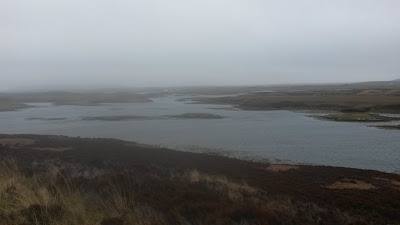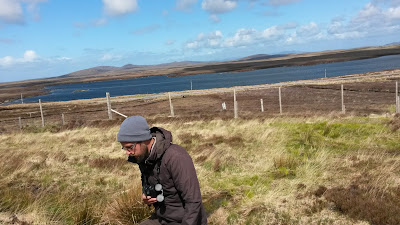We awoke on our last morning on North Uist to the still astonishing sound of Corncrake, before heading for the early Ferry.
The ferry terminal at Lochmaddy seemed an equally promising-looking area for keeping an eye on while we waited to depart, as the other side. And so it proved, with some movement on some nearby rocks turning out to be an Otter! Two of the my three UK Otter sightings have now come at Ferry terminals!
The journey across the Little Minch was not quite as eventful as last time, with just the usual seabirds (including Puffin) though there were a pair of Long-tailed Skua powering through, as well as two distant Pomarine Skua. A good farewell!
Once back on the mainland, we headed straight south, with just a brief stop for lunch at Ballachulish on the way.
We planned to head to County Durham, as we we'd noticed of a bit of hot gen about a site for both Grouse in the vicinity of the North Pennines AONB.
We eventually reached this picturesque area of moorland and pasture late afternoon.
As we drove along, Matt suddenly mentioned of an 'interesting' looking shape sitting on a post. I reversed back, only to discover a male Ring Ouzel foraging! Totally unexpected.
We had trouble locating the Grouse site, with seemingly little moorland in the area, which is where I expected both species to be. We instead had a walk round the isolated hamlet of Langdon Beck. This proved a gem of a spot, with Spotted Flycatcher, a Sand Martin colony, loads of breeding waders (including very numerous 'drumming' Snipe), and best of all, a confiding juvenile Dipper found on the beck itself.
This spot was also good for flowers, with Mountain Pansy...
...and Early Purple Orchid, around.
It was then by a bit of a fluke that I spotted some dark spots on a distant hillside - Black Grouse!
We got closer, and got great views of 6 males and a female from the car. Also a Hare in the same field.
We wanted to look for a place to camp for the night, so decided to explore a quiet minor road nearby. We stopped to scan over a valley, and I was astonished to come across a displaying male Black Grouse, no 2, 3, 4, actually, an entire lek of 20 males!!! What luck! What a spot to have our dinner, to the wonderful sounds of the lek. While we watched, a Short-eared Owl with prey suddenly shot behind the car! What a good spot this was.
After that triumph, we headed off towards Barnard Castle, in search for a camping spot. We eventually decided on a secluded wooded spot by the attraction of Gibson's Cave.
This proved to be another quality area, with more Spotted Flycatcher, and into the night, calling Tawny Owl and roding Woodcock.
We awoke the next morning to a perfect dawn chorus of Spotted Flycatcher, and new trip species of Treecreeper, Garden Warbler, Nuthatch, and Redstart. I disturbed a Dipper from the stream.
We soon moved off, heading for a stop-off at RSPB Blacktoft Sands, E. Yorks, in hope of the breeding pair of Montagu's Harrier. The nest-area was apparently viewable from the hides. Easy, surely?Once there, we ticked off various trip ticks including the ever present Tree Sparrow and Marsh Harrier...
We got back to Surrey for early evening. What an adventure!
I've been on trips with more species, I've been on trips with rarer species, I've been on trips with more lifers (I only got one), but never have I enjoyed a trip more! I think this was down to two things. The remarkably accessible and easily seen birds on the Uists, which pay little attention to cars being the first, and the great company of Matt being the second!
Full trip list (in brackets were not seen on the Hebs):
Mute Swan - Many
Whooper Swan - At least 3 individuals, at 3 sites, North Uist.
Greylag Goose - Many
(Canada Goose) - Ballachulish
Shelduck - Many
Wigeon - A couple of sites, North Uist and Benbecula.
(Gadwall) - Blacktoft
Teal - A couple of sites, North Uist and Benbecula.
Mallard - Many
Shoveler - Several
(Pochard) - Blacktoft
Tufted Duck - Many
Scaup - Loch Sandary
Red-breasted Merganser - Many
(Goosander) - Loch Lomond
(Black Grouse) - North Pennines
Red Grouse - Ben Langass
Pheasant - Lochmaddy
Red-throated Diver - Ben Langass, Aird an Runair, and Loch Eynort (S Uist)
Black-throated Diver - Aird an Runair
Great Northern Diver - Many
Fulmar - Little Minch and Aird an Runair
Manx Shearwater Little Minch and Aird an Runair
Storm Petrel - Little Minch
Gannet - Little Minch and Aird an Runair
Cormorant - Several
Shag - Many
(Little Egret) - Blacktoft
Grey Heron - Many
Little Grebe - A couple of sites, North Uist and Benbecula
Great Crested Grebe - Ben Langass
(Red Kite) - M40
(Marsh Harrier) - Blacktoft
Hen Harrier - Knockintorran, Ben Langass, Loch Portain, and Committee Road.
Sparrowhawk - Ben Langass
Buzzard - Several
Golden Eagle - Uig, Ben Riabhach, and Loch Eynort (S Uist)
Kestrel - Several
(Peregrine) - Blacktoft
Corncrake - Balranald, Knockintorran, Ardivachar Point (S Uist), Howmore (S Uist) Borgh (Benbecula)
Moorhen - Aird an Runair and one other.
(Coot) - Blacktoft
(Avocet) - Blacktoft
Oystercatcher - Many
Golden Plover - Aird and Runair and Malacleit
Lapwing - Many
Ringed Plover - Many
Whimbrel - Aird an Runair and Loch Euphort
Curlew - Ben Langass and Loch Euphort
(Black-tailed Godwit) - Blacktoft
Bar-tailed Godwit - Aird an Runair
Turnstone - Many
Sanderling - Aird an Runair and Ardivachar Point (S Uist)
Dunlin - Many
Purple Sandpiper - Aird an Runair
Red-necked Phalarope - Benbecula
Common Sandpiper - Many
Greenshank - Ben Langass and Loch Euphort
Redshank - Many
Snipe - Many
Pomarine Skua Little Minch and Aird an Runair
Arctic Skua - Several
Long-tailed Skua - Little Minch and Aird an Runair
Great Skua Little Minch and Aird an Runair
Puffin - Little Minch
Black Guillemot - Several
Razorbill - Little Minch and Aird an Runair
Guillemot - Little Minch and Aird an Runair
Little Tern - Grenitote
Common Tern - Lochmaddy and Loch Euphort
Arctic Tern - Many
Kittiwake - Little Minch and Aird an Runair
Black-headed Gull - Many
Common Gull - Many
Lesser Black-backed Gull - Grenitote
Herring Gull - Many
Iceland Gull - Aird an Runair and Grenitote
Great Black-backed Gull - Several
Rock Dove - Several
(Stock Dove) - North Pennines
Woodpigeon - Malacleit
Collared Dove - Several
Cuckoo - Many
(Tawny Owl) - Gibson's Cave
Short-eared Owl - Committee Road, Knockintorran, and Ben Langass.
(Swift) - Blacktoft
(Great Spotted Woodpecker) - Somewhere in Scotland...
(Magpie) - Blacktoft
(Jay) - Somewhere in Scotland...
(Jackdaw) - Blacktoft
(Rook) - Somewhere on Skye...
(Carrion Crow) - Somewhere in Scotland...
Hooded Crow - Many
Raven - Many
Goldcrest - Ben Langass and Loch Eynort (S Uist)
(Blue Tit) - Somewhere in Scotland...
(Great Tit) - Blacktoft
Skylark - Many
Sand Martin - Aird an Runair, Loch Sandary, and Loch Hosta.
Swallow - Many
(House Martin) - Blacktoft
(Cetti's Warbler) - Blacktoft
(Long-tailed Tit) - Blacktoft
(Chiffchaff) - Somewhere in Scotland...
Willow Warbler - Several
(Blackcap) - Fort William
(Garden Warbler) - Gibson's Cave
Whitethroat - Loch Eynort (S Uist)
Sedge Warbler - Several
(Reed Warbler) - Blacktoft
(Nuthatch) - Gibson's Cave
(Treecreeper) - Gibson's Cave
Wren - Many
Starling - Many
(Dipper) - Langdon Beck and Gibson's Cave
(Ring Ouzel) - Harwood
Blackbird - Many
Song Thrush - Several (Hebs race)
(Mistle Thrush) - Langdon Beck
Spotted Flycatcher - Loch Eynort (S Uist)
Robin - Many
(Redstart) - Gibson's Cave
Stonechat - Several
Wheatear - Many
Dunnock - Several
House Sparrow - Several
(Tree Sparrow) - Blacktoft
(Yellow Wagtail) - Blacktoft
(Grey Wagtail) - Langdon Beck and Gibson's Cave
Pied Wagtail - Many
(Tree Pipit) - Loch Lomond
Meadow Pipit - Many
Rock Pipit - Loch Euphort
Chaffinch - Several
Greenfinch - Benbecula
Goldfinch - Loch Eynort (S Uist)
Linnet - Benbecula
Twite - Aird an Runair and Loch Euphort
Redpoll - Loch Eynort (S Uist)
(Bullfinch) - Somewhere in Scotland...
(Yellowhammer) - Somewhere in Scotland...
Reed Bunting - Loch Sandary
Corn Bunting - Aird an Runair
Total: 102 (146)









